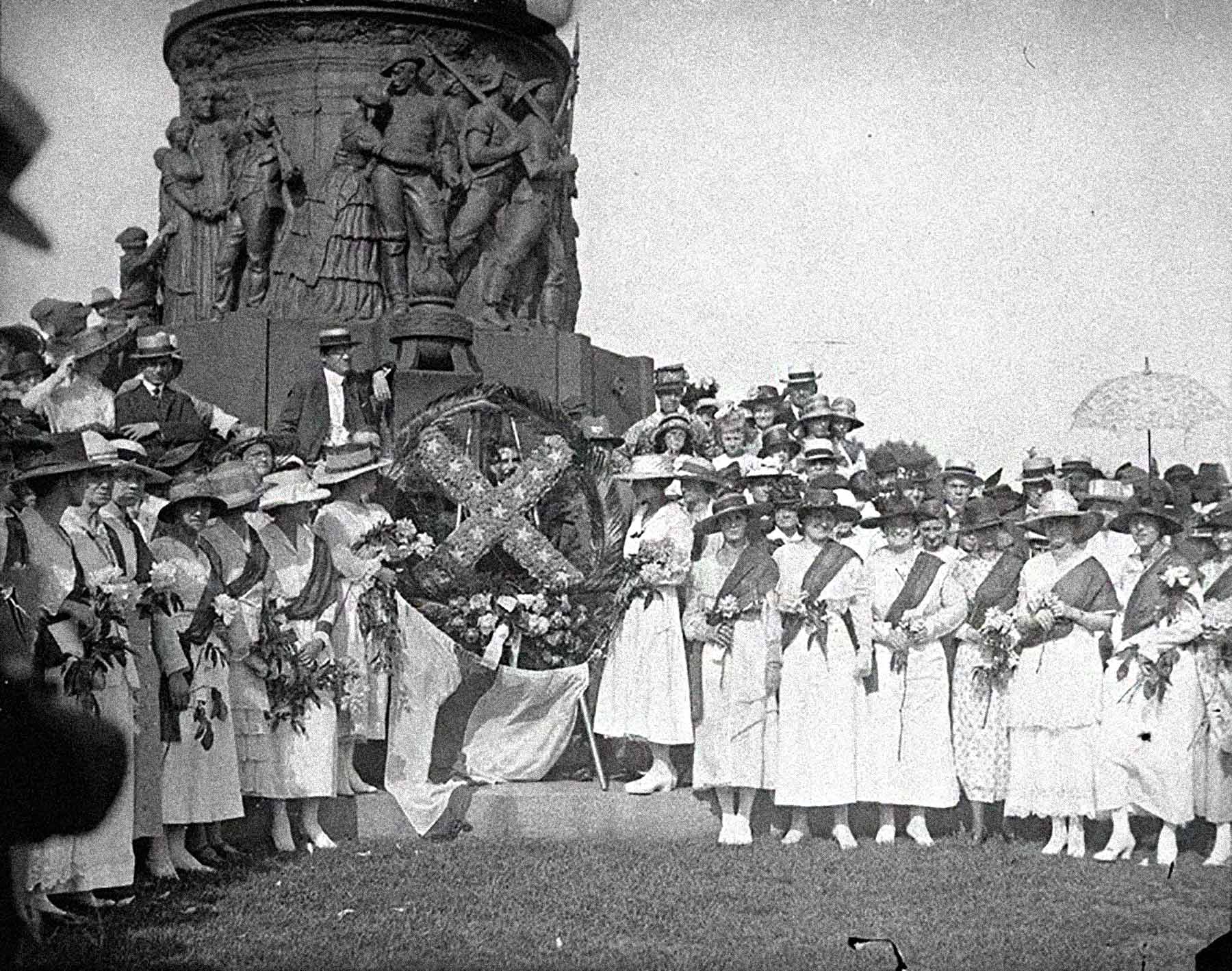
On June 4, 1917, the Daughters of the Confederacy unveil the “Southern Cross” monument in Arlington, Virginia. (Bettmann/Getty Images)
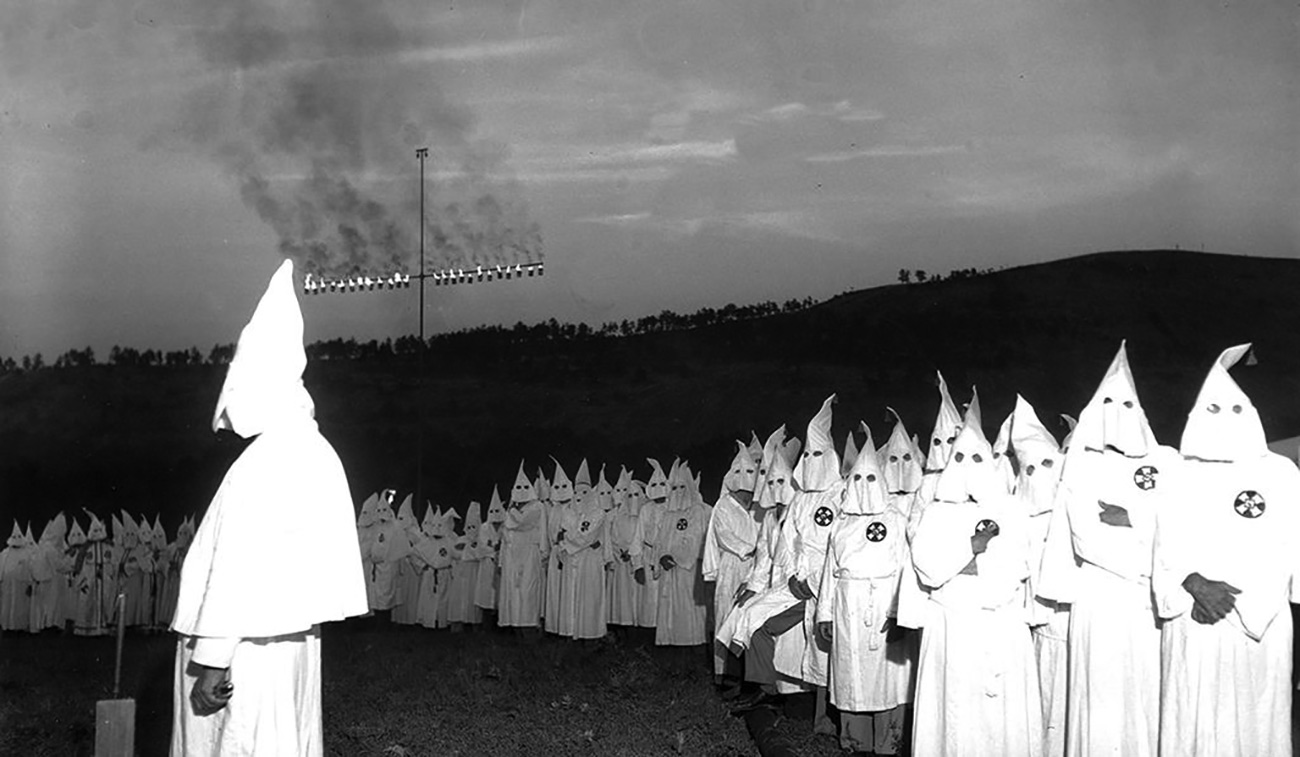
Members of the Ku Klux Klan burn a large cross atop Stone Mountain in DeKalb County, Georgia, on July 23, 1948, while initiating 700 new members. (AP Photo, File)
Much of the Southern — and then national — retelling of the history of the Civil War and the Confederacy took place through monuments and the organizations that formed to erect them. Around the turn of the 20th century, white Southerners installed monuments to the Confederacy across the South as part of a concerted effort to redeem their defeat and build cultural support for the re-establishment of white supremacy.614 David Blight, “Historical Context of Civil War Monuments,” American History TV, October 23, 2017, https://www.c-span.org/video/?436091-1/historical-context-civil-war-monuments.
Former President of the Confederacy Jefferson Davis, and others, sought to promote a new, “Lost Cause” narrative about the 19th century.615 David Blight, Race and Reunion (Cambridge: Belknap Press, 2001),258-59 Lost Cause supporters argued that the Civil War was not about slavery, but was instead a fight between an industrializing North and a romanticized South.616 Ibid., 259. As Davis told it, the North attempted to exercise “unlimited, despotic power” over sovereign Southern states, and Reconstruction extended that federal conquest.617 Ibid. This narrative minimized the Confederacy’s military defeat and instead celebrated the South’s triumph over Reconstruction, including the withdrawal of federal troops and restoration of the racial hierarchy. As Edward Pollard, a leading campaigner for the movement, wrote in The Lost Cause: “To the extent of securing the supremacy of the white man, [the South] really triumphs in the true cause of the war.”618 Ibid., 260.
The evolution and promotion of the Lost Cause narrative can be seen in Confederate monuments. The first, installed in cemeteries in the 1860s to memorialize fallen soldiers, typically were modest structures that reflected a sentiment of personal mourning.619 Gaines Foster, “Historical Context of Civil War Monuments,” American History TV, October 23, 2017, https://www.c-span.org/video/?436091-1/historical-context-civil-war-monuments; ibid., 260.
In the decades that followed, organizations like the United Daughters of the Confederacy, which had 100,000 members by the start of World War I, and the Sons of Confederate Veterans began to install Confederate monuments in locations with far more political significance, such as courthouse lawns and town squares. These groups nonetheless maintained publicly that they were motivated by an apolitical desire to honor their ancestors.620 Karen Cox, “Historical Context of Civil War Monuments,” American History TV, October 23, 2017, https://www.c-span.org/video/?436091-1/historical-context-civil-war-monuments.
These new monuments romanticized and glorified the effort to preserve slavery by framing Southern secession as an effort to defend local autonomy and states’ rights. During this era of racial terrorism, disenfranchisement, and violent repression targeting African Americans, Confederate monuments, memorials, and other symbols played a vital role in restoring the racial hierarchy that would continue to dominate life in the American South and influence thinking on racial equality nationwide.
Confederate monuments often received political endorsements from outside the South, including from the federal government. The North’s appeasement of white Southerners included actively funding the creation of a cultural landscape designed to perpetuate white supremacy and the racial subordination of Black people. At a 1927 dedication ceremony for a federally-funded statue of Jefferson Davis in Mississippi, Senator John Sharp Williams of Mississippi proclaimed that the Confederacy did not fight to preserve slavery, but to preserve “[t]he cause of White Racial Supremacy, which . . . is not a ‘Lost Cause.’ It is a Cause Triumphant. It was never as safe as now since the Missouri Compromise . . . The white man’s family, life, his code of social ethics, his racial integrity — in a word his civilization — the destruction of which in the slave states was dreaded . . . are safe.”621 The Jefferson Davis Memorial in the Vicksburg National Military Park, Dedication Ceremonies Pamphlet, October 13, 1927.
By 1950, at least 1000 Confederate monuments stood throughout the South, including more than 300 installed on the grounds of a courthouse. Every Southern state capitol building had at least one monument to the Confederacy.622 Based on EJI research.
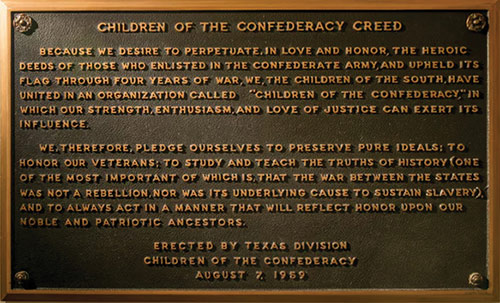 A 2017 photograph shows the Children of the Confederacy Creed plaque that was installed at the Capitol in Austin, Texas, in 1959, during the heart of the Civil Rights Movement. (Jay Janner/Austin American-Statesman via AP)
Confederate symbols and monuments gained prominence as African Americans began demanding civil rights and equal treatment in the mid-20th century. The Dixiecrats used Confederate symbols to brand themselves as champions of the struggle for states’ rights,
and under this guise, they resisted growing calls for racial equality.623
New York Times, “Strom Thurmond, Foe of Integration, Dies at 100,” June 27, 2003.
A 2017 photograph shows the Children of the Confederacy Creed plaque that was installed at the Capitol in Austin, Texas, in 1959, during the heart of the Civil Rights Movement. (Jay Janner/Austin American-Statesman via AP)
Confederate symbols and monuments gained prominence as African Americans began demanding civil rights and equal treatment in the mid-20th century. The Dixiecrats used Confederate symbols to brand themselves as champions of the struggle for states’ rights,
and under this guise, they resisted growing calls for racial equality.623
New York Times, “Strom Thurmond, Foe of Integration, Dies at 100,” June 27, 2003.
Throughout the 1950s and 1960s, scores of new Confederate monuments were added to the Southern landscape, many in direct response to federal desegregation efforts. In 1955, one year after the Supreme Court struck down segregated public schools
in Brown v. Board of Education, a bronze figure of Robert E. Lee was placed in front of Robert E. Lee High School in Montgomery, Alabama. A few months later, as part of its opposition to Brown, Georgia redesigned its state flag to
include the Confederate battle flag. Standing in front of his state’s new flag, Governor Marvin Griffin declared that federal desegregation laws were “imperil[ing] the mores of the South.”624
Mark Sherman, “Pledging Allegiance at Flag Forum,” Atlanta (Ga.) Journal Constitution, Jan. 29, 1993.
In the 1960s, in reaction to the passage of the Civil Rights Act and Voting Rights Act, Texas installed 27 Confederate monuments dedicated to Confederate soldiers who had fought against “the federal enemy.” In 1964 alone, an additional 16 monuments were
dedicated across the South. That same year, Florida joined Georgia and South Carolina in flying the Confederate battle flag on its courthouse lawns.
625
Miami (Fla.) Herald, “Rebel Flag Divides Panhandle County: North vs. South Turned Around,” July, 27, 2015
The flags augmented a landscape littered with the iconography of white supremacy and racial inequality.
The Confederate battle flag also became a staple at white segregationist protests and rallies. Segregationists displayed Confederate flags when African Americans attempted to integrate schools and order at segregated lunch counters, and white
residents hung Confederate flags along the route of the voting rights march from Selma to Montgomery.626
Matt Herron Photography, “Selma to Montgomery March, Part II,” http://www.takestockphotos.com/imagepages/imagedetail.php?PSortOrder=46&FolioID=7.
White children followed this example: in June 1966, when Dr. Martin Luther King Jr. led a civil rights march along U.S. 51 near Como, Mississippi, a white boy played Dixie on his clarinet while a young white girl stood beside him waving a Confederate
flag.627
The Atlantic, “Remembering Martin Luther King Jr. in Photos,” January 19, 2015.
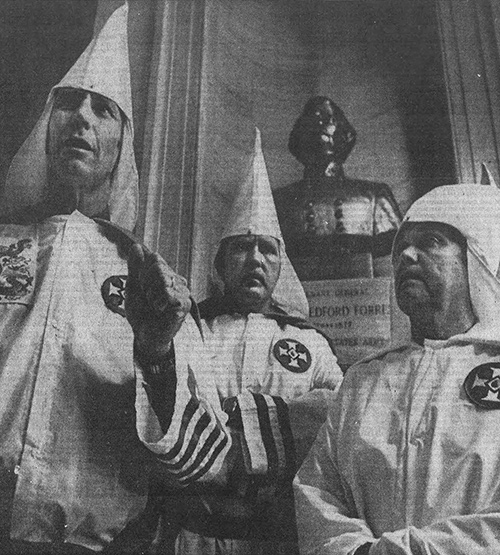 Klan members hold a press conference in front of the Nathan Bedford Forrest bust at the capitol in Nashville, Tennessee, in 1980 to discuss training SWAT teams in preparation for the “race war.” (Tennessean via Newspapers.com)
Confederate iconography continued to gain traction outside the South. The year after Brown, Robert E. Lee Elementary School was founded in East Wenatchee, Washington. Confederate monuments were installed as far north as Maine and as far
west as Oregon. Brooklyn, New York, still maintains General Lee Avenue and Stonewall Jackson Drive. In 2009, early in President Barack Obama’s first term, a South Dakota police department created an official badge featuring the Confederate flag.
Klan members hold a press conference in front of the Nathan Bedford Forrest bust at the capitol in Nashville, Tennessee, in 1980 to discuss training SWAT teams in preparation for the “race war.” (Tennessean via Newspapers.com)
Confederate iconography continued to gain traction outside the South. The year after Brown, Robert E. Lee Elementary School was founded in East Wenatchee, Washington. Confederate monuments were installed as far north as Maine and as far
west as Oregon. Brooklyn, New York, still maintains General Lee Avenue and Stonewall Jackson Drive. In 2009, early in President Barack Obama’s first term, a South Dakota police department created an official badge featuring the Confederate flag.
Today, the South is fighting to preserve thousands of Confederate monuments. In recent years, Alabama, Georgia, Mississippi, North Carolina, South Carolina, Tennessee, and Virginia passed “heritage” laws to protect Confederate monuments628
Huffington Post, “Several States Have Erected Laws to Protect Confederate Monuments,”August 17, 2017).
in light of increasing public pressure to remove them.629
Asheville (N.C.) Citizen Times, “Controversial North Carolina Monuments Bill Becomes Law,” July 23, 2015.
In 2017, Alabama Governor Kay Ivey signed a memorial preservation law that forbids “the relocation, removal, alteration, renaming, or disturbance of any architecturally significant building, memorial building, memorial street, or monument
on public property which has been in place for 40 years or more.”630
Huffington Post, “It’s Now Illegal in Alabama to Remove Confederate Monuments,” May 27, 2017.
The Attorney General used the law to block the City of Birmingham from removing a prominent Confederate monument from a city park; today, the monument remains in place, covered in plywood.
In an effort to better understand the scope and depth of the South’s commitment to Confederate iconography, EJI has worked to identify and locate Confederate monuments across America. We have documented more than 1575 Confederate monuments total, the vast majority of which were put up after 1910. 1568 Confederate monuments are located across the 12 Southern states at their original locations in town squares, on courthouse lawns, and at each and every state capitol. Hundreds of additional Confederate symbols and school and street names dominate this region as well.
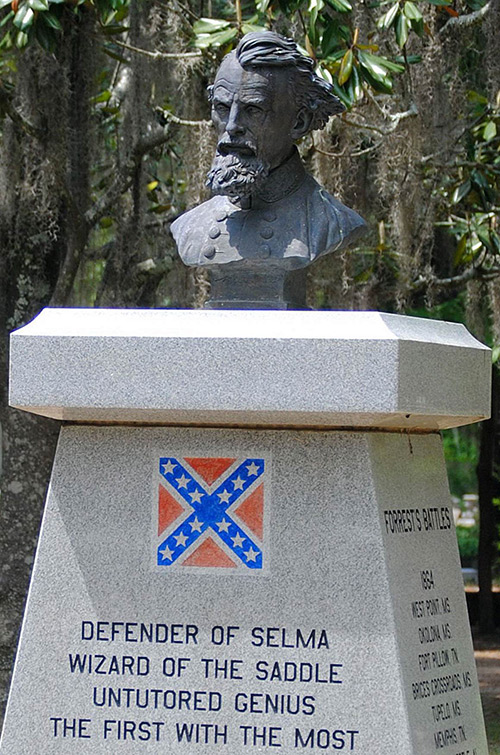 This monument celebrating Nathan Bedford Forrest was unveiled
in Selma, Alabama, in 2015. Forrest was a Confederate Army General
and an early leader of the Ku Klux Klan (AP Photo/Alvin Benn,
Montgomery Advertiser)
There are more than 100 Confederate monuments in Alabama. The placement of these monuments reflects deep government support for Confederate memorialization. Four Confederate monuments stand on the grounds of the state capitol building, and monuments appear
on the grounds of at least five schools in Alabama, including at the center of campus at the University of Alabama. More than a third of county courthouses in the state have Confederate monuments. The Bibb County courthouse monument, erected in
1920, bears an inscription proclaiming, “No nation rose so white and fair, or fell so pure of grime” as the Confederate States of America. About 25 percent of the state’s courthouse monuments were erected within the last 30 years.
This monument celebrating Nathan Bedford Forrest was unveiled
in Selma, Alabama, in 2015. Forrest was a Confederate Army General
and an early leader of the Ku Klux Klan (AP Photo/Alvin Benn,
Montgomery Advertiser)
There are more than 100 Confederate monuments in Alabama. The placement of these monuments reflects deep government support for Confederate memorialization. Four Confederate monuments stand on the grounds of the state capitol building, and monuments appear
on the grounds of at least five schools in Alabama, including at the center of campus at the University of Alabama. More than a third of county courthouses in the state have Confederate monuments. The Bibb County courthouse monument, erected in
1920, bears an inscription proclaiming, “No nation rose so white and fair, or fell so pure of grime” as the Confederate States of America. About 25 percent of the state’s courthouse monuments were erected within the last 30 years.
Arkansas
There are now nearly 50 Confederate monuments in Arkansas, including 12 in Pulaski County, where Little Rock is located. The state capitol building in Little Rock has three Confederate monuments on its grounds, and its previous location
features four Confederate monuments. The United Daughters of the Confederacy was particularly active in Arkansas, sponsoring nearly 70 percent of Confederate monuments in the state.
Florida has at least 57 monuments honoring the Confederacy spread throughout half of its counties. No less than seven counties have monuments on their courthouse lawns, and at least 10 additional monuments are prominently displayed in Florida towns. As in many other Southern states, the most active sponsors of Confederate monuments in Florida are the United Daughters of the Confederacy and the Sons of Confederate Veterans, which recently created a “Flags Across Florida” project to install large Confederate flags in locations visible from well-traveled roadways. To date, the project has completed at least three installations, including an oversized Confederate flag on a 139-foot pole accompanied by a large semicircle of stone monuments celebrating the “timeless” nature of the Confederate cause.
Georgia is home to more than 160 monuments honoring the Confederacy. More than 90 of the state’s 159 counties have at least one Confederate monument, and more than nearly 50 counties have one on their courthouse lawns. No fewer than four Confederate monuments
decorate the grounds of Georgia’s capitol building, including one prominent monument to John Gordon, a Confederate general and senator who staunchly opposed Reconstruction and reputedly led Georgia’s Klu Klux Klan. The capitol also features a
monument to Joseph Brown, the governor who led Georgia’s secession in 1861.
The largest Confederate monument in the United States is Georgia’s Stone Mountain. Known as the site of the first gathering of the “Second” Ku Klux Klan in 1915, Stone Mountain was given to the United Daughters of the Confederacy in 1916.
The landowners, the Venable brothers, requested that the organization design a Confederate monument at the mountain’s scale, and granted a “perpetual easment” to the KKK to continue to access the site for gatherings. In 1960, the state purchased
the site and completed the long-delayed construction of the monument, which opened in 1972. The elaborate and massive tribute to the Confederacy remains open today.
The more than 50 Confederate monuments in Kentucky are mostly in cemeteries, but at least 10 counties have Confederate monuments on their courthouse lawns. Kentucky celebrates its connection to Jefferson Davis, who was born in the state, with a marble sculpture in its capitol building inscribed “Patriot — Hero — Statesman.” A state park commemorating Davis’s birthplace includes a 351- foot monument to Davis modeled after the Washington Monument.
More than half of Louisiana’s 65 Confederate monuments were installed by the United Daughters of the Confederacy and the Sons of Confederate Veterans. The capitol grounds contain at least three Confederate markers, and at least 12 parish courthouses feature Confederate monuments. The front entrance to the Supreme Court of Louisiana boasts a monument to Justice E.D. White, who fought in the Confederate Army before he joined the United States Supreme Court and voted with the majority to uphold segregation in Plessy v. Ferguson. A “Good Darky” or “Uncle Jack” monument stands in the Louisiana State University Rural Life Museum in Baton Rouge. The statue, erected by a white businessman in 1927 and moved to the museum in 1974, depicts a supplicating African American man and an original placard that reads: “Dedicated to the arduous and faithful services of the good darkies of Louisiana.”
Mississippi has at least 175 monuments honoring the Confederacy, at least 26 of which are installed on courthouse lawns. Fifteen towns prominently display Confederate monuments in their civic landscapes. Many of Mississippi’s Confederate monuments were installed with the support of the federal government as part of the Vicksburg National Military Park. One of the park’s most prominent monuments is a statue of Jefferson Davis that the State of Mississippi gave to the federal government to install on the site. During the 1927 unveiling ceremony attended by state and federal officials, Senator John Sharp Williams dedicated the monument to “[t]he cause of White Racial Supremacy.”
North Carolina has at least 190 Confederate monuments in more than 80 of its 100 counties. At least 50 counties have Confederate monuments on their courthouse lawns, and there are at least four monuments on the grounds of the state capitol. Many of North Carolina’s Confederate monuments have been placed in locations explicitly associated with voting, including in front of community centers and other polling places. In Gatesville, North Carolina, a tall Confederate monument installed in 1915 was placed directly in front of the County Board of Elections building.
South Carolina has at least 92 monuments honoring the Confederacy, and more than 80 percent of its counties have at least one monument. The state capital in Columbia has seven different monuments to the Confederacy, and three other major public parks in the city — Marion Square, Washington Square Park, and White Point Gardens — have highly visible Confederate monuments at their centers. Marion Square Park houses a massive monument to white supremacist John C. Calhoun, just a half block from the Mother Emmanuel AME Church, site of the racially-motivated murders of nine African American parishioners in 2015.
At least 30 of Tennessee’s more than 100 Confederate monuments were installed after 1976. As in other states, the United Daughters of the Confederacy and the Sons of Confederate Veterans have been the most active in promoting Confederate memorials, and the two groups are responsible for more than 60 of the state’s monuments. In 1978, the Sons of Confederate Veterans installed a bust of Confederate general and early organizer of the Ku Klux Klan, Nathan Bedford Forrest, in the central corridor of Tennessee’s state house. The State of Tennessee has resisted recent efforts to move the bust, and in 2017, the Tennessee Capitol Commission refused to allow it to be relocated to the Tennessee State Museum. Just south of the capitol, a 25-foot, full-color fiberglass statue of Forrest on horseback sits on private land within view of a major interstate highway; when Nashville city leaders asked the Tennessee Department of Transportation to assist in obscuring the controversial monument by planting trees or shrubbery on the public roadside, the agency refused.
At least 137 monuments honoring the Confederacy are spread out across 86 Texas counties. Unique in the extent to which it has sponsored monuments to the Confederacy, Texas has installed at least 34 Confederate monuments, including 27 erected between 1963 and 1965, during the heart of the Civil Rights Movement. Since 1959, the state capitol building has housed a placard featuring the “Children of the Confederacy Creed,” which vows to “preserve pure ideals [and] study and teach the truths of history (one of the most important of which, is that the War Between the States was not a rebellion, nor was its underlying cause to sustain slavery).”
Home to Richmond, the last capitol of the Confederacy, Virginia has the most Confederate monuments in the country. About 75 of Virginia’s 376 monuments are placed on courthouse lawns, and the state capitol building in Richmond is home to three Confederate monuments — including a tall likeness of Stonewall Jackson. Most dramatic is Richmond’s “Monument Avenue,” an immaculately groomed roadway displaying five massive monuments dedicated to Confederate leaders. Several Virginia universities embrace their ties to the Confederacy: Washington and Lee University maintains Lee Chapel, where Robert E. Lee is interred below a large marble sculpture of the Confederate general in uniform that stands in place of an altar. At the Virginia Military Institute, a bronze monument to Stonewall Jackson looms over the parade grounds at the heart of campus. Virginia’s monuments were brought into the national spotlight in 2017 when a peaceful counterprotestor was violently killed as white supremacists rallied in Charlottesville to “defend” a statue of Robert E. Lee that had been slated for removal.
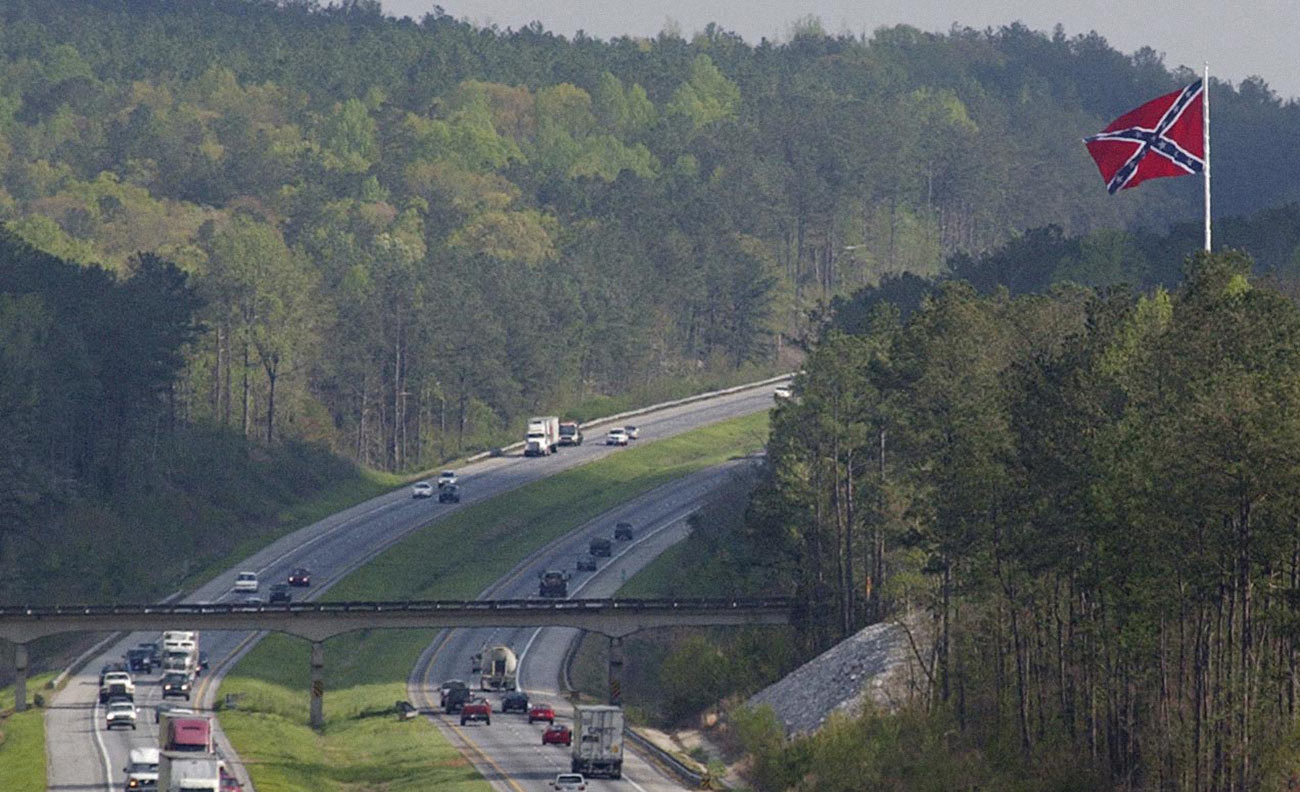
The Alabama Division of the Sons of Confederate Veterans installed a Confederate flag on a 100-foot-tall pole along Interstate 65 in Verbena, Alabama, in 2005, and it is still flying today. (Mickey Welsh/Bloomberg via Getty Images)